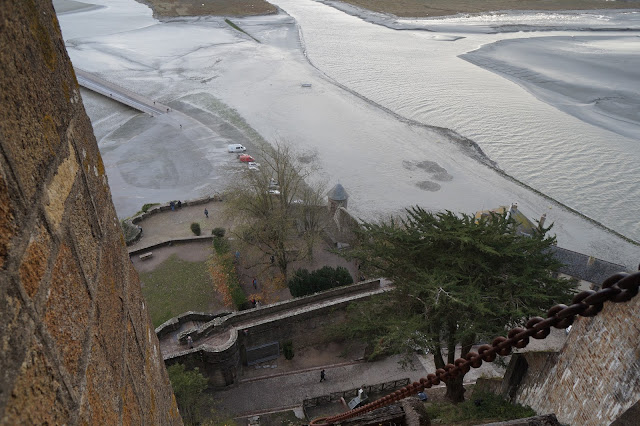Le Mont-Saint-Michel (Saint Michael's Mount)
Mont-Saint Michel is an island in Normandy. It is located off France's northwestern coast, at the mouth of the Cousenon River and is 247 acres in size.
The island has held strategic fortifications since ancient times and since the 8th century AD has been the seat of the monastery from which it draws its name. The structural composition of the town exemplifies the feudal society that constructed it: on top,God, the abbey and monastery; below, the great halls; then stores and housing; and at the bottom, outside the walls, houses for fishermen and farmers.
It is accessible at low tide to the many pilgrims to its abbey, but defensible as an incoming tide stranded, drove off, or drowned would-be assailants. The Mont remained unconquered during the Hundred Year's War; a small garrison fended off a full attack by the English in 1433. The reverse benefits of its natural defense were not lost on Louis XI, who turned the Mont into a prison.
Info from Wikipedia
After about a three hour drive, including a "diversion", their name for detour, that was not very clear as to which way to divert, this was our introduction to this great location. We had to circle the parking area about three times in order to figure out how and where we were to park. We finally managed to get into a parking lot and discovered that we were to walk to the shuttle bus area to be shuttled to the island.
The shuttle bus still parked us about this far back, we are unsure why, except to give us an opportunity to take these shots of the Mont. It was very difficult to walk because the wind was blowing against us. I felt like I could have leaned against this wind.
This is obviously at low tide. At high tide, this is all covered with water.
A dam built at the mouth of the river regulates the ebb and flow of the water.
The word for this day was "fantastical!" That is what kept going through my mind as we walked around this wonderful place. It just did not feel real. I could truly imagine myself being transported back to the 11th or 12th century as I walked the streets.
We soon "diverged" off the street to climb the ramparts.
We kept climbing....
and climbing...
and climbing up to get to the Abbey!
The weather could not seem to make up its mind as to what to do this day.
At first we were not going to go into the Abbey, but we decided it was a must.
And, yes, it is a must. It was wonderful!
The long history of Mont-Saint Michel is thought to date back to 708AD, when Aubert, Bishop of Avranches, had a sanctuary built on Mont-Tombe in honor of the Archangel, Michael. The mount soon became a major focus of pilgrimage. In the 10th century, the Benedictines settled in the abbey, while a village grew up below its walls. By the 14th century it extended as far as the foot of the rock. An impregnable stronghold during the Hundred Years War, Mont-Saint Michel is also an example of military architecture. Its ramparts and fortifications resisted all the English assaults and as a result the Mount became a symbol of national identity.
Suspended passageways linking the church and the abbey buildings above the Saut-Gaultier terrace. These buildings were put up between the 14th and 16th century and were stately residences of the abbots.
The abbey church was constructed on the top of the rock in the early decades of the year 1000AD. The medieval builders wrapped the buildings of the abbey around the granite rock.
The structure of the nave is covered with a wood-panelled barrel vault. The Romanesque chancel, which collapsed in 1421, was rebuilt after the Hundred Years War in flamboyant Gothic style.
This cloister was a place of prayer and meditation. Processions were held
here during religious festivals.
Views from the cloister.
The refectory was where the monks would take their meals in silence,
while one of them gave a reading from the pulpit on the south wall.
The refectory is directly above the Guest Hall.
This was seen in the stairway leading to the Guest Hall.
This picture does not truly give you the size these fireplaces were. They were monstrous.
The Guest Hall was designed for receiving royalty and nobility.
The above picture is taken standing in one of the fireplaces.
We saw several rainbows this day.
The crypt was directly under the church. This window is in the floor of the church. This crypt is known as the great pillared crypt because the pillars are huge. The crypt was built in
the mid 15th century to support the Gothic chancel of the abbey church.
The former monk's ossuary is where a wheel was installed in order to hoist
provisions to the prisoners held in the abbey when it was a prison.
This is the outside where the provisions were hoisted up.
Views from the ossuary.
Saint Etienne Chapel was the chapel of the dead.
North-south stairs, the main axis of circulation of the monastery.
The Covered Walk is a long room with a double nave. Its architects designed it with ribbed vaults: an innovation that was the harbinger of Gothic art in early 12th century.
The Knights Hall was the work and study room of the monks.
Much of their intellectual work was done here.
Then we take the stairs that seemed to be unending to the conclusion of our Abbey Tour!
After leaving the Abbey, we continued around Mont-Saint Michel
Of course, we have to include a puppy picture!!!
Our final picture as we leave this storybook place!






















































































No comments:
Post a Comment